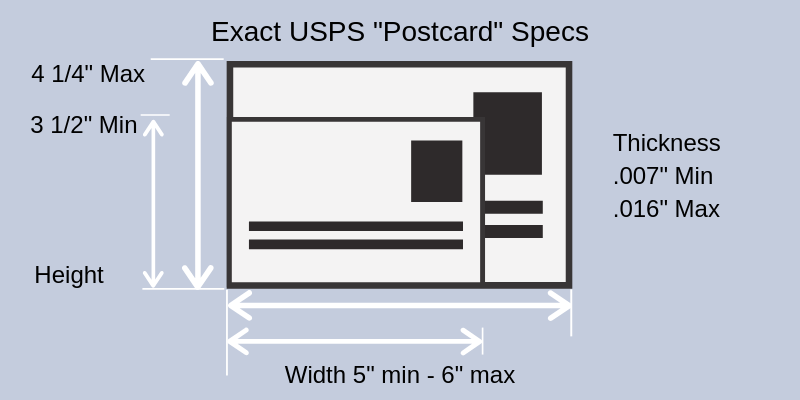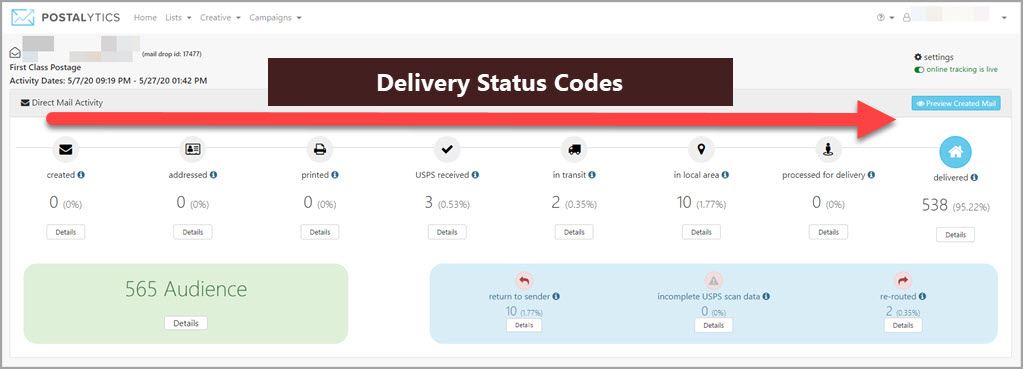
New tech helps marketers leverage USPS direct mail with efficiency and cost savings — despite the headlines that suggest otherwise.
The U.S. Postal Service (USPS) always seems to get a bad rap. Until only recently, that mostly took the form of really bad jokes – but lately, plenty of controversy and criticism surrounding voting by mail and the financial viability of its business model.
Yet when it comes to moving the mail, the USPS does an amazing job. In fact, the USPS delivered about 150 billion pieces of mail in 2019, operates over 31,000 Post Offices and is often the only delivery option for more than 46 million rural US residents (Source: USPS).
The infrastructure and logistics required to run an operation of this scale with reliability is truly astounding.
Imagine, you as a marketer gets to take advantage of this massive investment when you utilize the USPS direct mail system to help you get your message into the hands of your audience.
For a much lower price per piece than just about anywhere else in the world.
And while the former “U.S. Post Office Department” was originally subsidized, that changed when the department became the United States Postal Service.
Then those subsidies largely vanished, so the USPS now has a mandate to do all it can to run more efficiently. Read on to learn how to leverage this massive, efficient system to help you grow.
Table of contents
- USPS direct mail incentives to reduce postage costs
- Design with postage savings in mind
- Make sure lists and data are accurate and up to date
- Choose the right postage class for your direct mail
- Saturation mailings make it easy to cost effectively blanket entire geographies
- Let USPS Direct Mail and Postalytics work for you
USPS direct mail incentives to reduce postage costs

To help you save money on postage, USPS offers plenty of resources. In many cases, these services are available at no charge or for a modest additional fee.
And by following some specific standards for designing and sending your USPS direct mail, you can take advantage of the best possible postage pricing.
In the old days, you had to hire a mailing company to decipher all the many rules and specifications that help you take advantage of these incentives. Now direct mail automation tools like Postalytics make it easy.
You see, when we started Postalytics, we created a platform that automatically optimizes mailings to:
- meet USPS direct mail specifications for the best possible postage rates and
- to take advantage of all the advanced logistics and technologies that USPS offers.
Learning how USPS works makes a big difference in making the most of a direct mail marketing budget. So here are some tips to consider that can help you save money:
Design with postage savings in mind

Long ago you could mail almost anything, but today the USPS sets standards so that mailers that are that are generally rectangular and don’t exceed specific height and width specifications get lower postage rates.
Any direct mail piece you send through Postalytics is automatically formatted for the best possible USPS postage rate. We designed it that way and have put safeguards in place to ensure you’re design meets the exact criteria.
Often marketers will try an unusually shaped design to attempt to get more attention. But we’ve learned, from millions of direct mail pieces sent, you’ll get better results in the long term if you keep your postage rates down.
If you can get a similar response rate for less money, that alone gets you more for your marketing dollar.
Here are a few of the variables that you need to account for to optimize your postage rates:
- Height and Length
- Shape
- Paper thickness
- Address location
- Color
Below are two example postcards. They’re very similar, the first measures 4 inches by 6 inches. The second measures 4 inches by 4 inches:


Even though the first postcard is two inches longer, the USPS can process it easier. That means you can save 47% savings on postage for sending the larger postcard!
I don’t see all that much of a difference between these two, yet those postage savings can add up to thousands of dollars per campaign.
Make sure lists and data are accurate and up to date
As I’ve written about again and again, the message you send in a direct mail piece is certainly important, but the list you’re using has about the same impact on response rates. Great offers that deliver on-target messaging must reach the right target. The best creative executions and offers mean little if the list you’re using isn’t on-target, too.

Think about it this way: If you were 90% sure that half your list wouldn’t respond – and you knew which half that was, would you eliminate those names from your mailing? Of course. And USPS has plenty of resources you can access within Postalytics to keep your lists accurate and up to date.
Through Postalytics, you can easily manage your leads and prospects and even import lists directly from your CRM or Marketing Automation tools.
Postalytics is integrated with two USPS list data cleansing services that you can access through the platform. Every piece of mail processed through Postalytics is run through:
National Change of Address (NCOA)
This is a USPS database of households and businesses which have recently moved. This helps you reduce undeliverable mail by making sure you have the most current address information and so that you can update your own list for future mailings.
Coding Accuracy Support System (CASS)
You get additional postage discounts when barcodes are printed on your mailer. But USPS wants to make sure those bar codes are accurate. By verifying that information through CASS, you can qualify for discounts when you use barcodes. Postalytics is CASS-certified, so you don’t even need to worry about this process – another way you can save time and money.
Choose the right postage class for your direct mail

USPS direct mail can be sent via various different postage rate classifications based on your needs. For marketing purposes, there are two mailing classifications that are most relevant:
- First class mail up to 13 ounces: First-class mail is delivered quickly, usually within three days and with very little variability in delivery times, even in peak season. And first-class mail is automatically forwarded to a new address if the recipient has moved. Although first-class mail is the most expensive mailing class, it can provide an improved ROI for time-sensitive offers.
- Marketing or Standard mail: Traditionally, marketers use this class of mail for non-time sensitive because the postage rates are a lot lower. (Around 30% less per piece!) Although marketing mail is handled less quickly, improved USPS logistics have reduced delays so that it typically takes only a few days extra days to be delivered. There is more variability around delivery times during peak seasons. Standard mail rates are available on certain USPS approved form factors only.
The Postalytics platform makes it easy to create and send customized direct mail packages through pre-defined templates. Each is designed to meet USPS direct mail standards for the most cost-effective postage rates for letters and postcards, whether you want to send marketing mail or first-class mail.
Best of all, you don’t need to worry about minimum mailing quantities for marketing mail. Sure, we make it easy to send out hundreds or thousands of mailings at once, but you can send one or two a day based on your marketing workflow at almost the same cost per piece as if you sent thousands.
Saturation mailings make it easy to cost effectively blanket entire geographies
If you’ve got an offer that you’d like to communicate to consumers in a specific geography, and you don’t want or need to personalize your creative, a saturation mailing might be your best bet.
What’s a saturation mailing? A simple and cost-effective way to “saturate” entire neighborhoods by sending a mailer to every household in a Zip Code or specific neighborhoods based on a specific postal carrier route.
You’ve seen them — they are addressed to “Occupant” or “Current Resident”. While they’re not fancy, saturation mailings are a very inexpensive way to ensure every household in a geography sees your message.
There are two ways to send saturation mailings.
First, the USPS offers Every Door Direct Mail® (EDDM®) service. Using EDDM, you can send your letter or postcard to specific Zip Codes, yet also select groups based on U.S. Census data information on age, income, and household size. But U.S. Census data can be pretty old — and using stale data can reduce your response rate.
A better way is to use an “Occupant List” from a list broker or data company. Occupant lists cover 99% of all deliverable addresses in the U.S., so you can blanket geographies based on radius, zip code, carrier route and more.
Best of all, Occupant Lists are updated continually (every month) and are very inexpensive. For as little as $.008/address, you can rent a list and start mailing.
Best of all, it’s easy to select specific groups and send Occupant List saturation mail directly from Postalytics. You can upload your list in seconds and start sending. Here’s what the list upload process looks like:

And through Postalytics, it’s easy to use Occupant Lists to target your message to specific audiences in specific locations.
Saturation mailing examples
Here’s an example of how this can help boost your direct mail marketing performance. If you’re marketing your local landscaping business, you might be getting a 0.50% response rate with a general message that looks something like this:

But your message could easily be more specific, perhaps calling out the name of a specific town or neighborhood like in this example:

That one headline change could easily boost your response by 50% or more. If your mailing costs 80 cents each, that means you can cut your cost per response from more than $16 to about $10 per response.
Sound complicated? Not at all! With Postalytics, you can easily create a wide variety of templates each versioned to specific groups and set up a schedule to send a few mailings per day or thousands all at once in just a few minutes.
More visibility and data to make more informed decisions
Another USPS direct mail tool, Informed Visibility (or Intelligent Mail Barcode), gives you the ability to track all of your mail so you know when it’s about to be delivered and when each pieces reaches the mailbox you’re sending it to.

This makes it a lot easier to plan marketing programs because you can be ready to respond to leads and set up specific follow-up mailing dates based on actual delivery, not just when you think the mailing arrived. Even better, you can use this information to integrate other marketing tactics more precisely — such as email, social media, or phone calls — so you can boost the impact of your campaign.
Let’s say you know that if you send an email with 24 hours after a mailing is delivered, you can boost response by 10% more than if your email arrived even a day later. That reduces your cost per response by 10% and the service doesn’t cost anything.
With Postalytics, every piece of mail processed gets an Intelligent Mail Barcode, so you have access to all of this data. You can even see this information in a comprehensive campaign dashboard and give you access to it programmatically via our integrations and API.
What’s more, you can test various follow-up strategies and timing to determine which ones work best. If you find one that increases your ROI even more, all the better!
Let USPS Direct Mail and Postalytics work for you
The USPS may not be a true private corporate business, but if it were, it would rank 44th in the Fortune 500. Because USPS has an incentive to make mailing less expensive and more efficient, that’s good news for you — if you can take advantage of those incentives.
As I’ve mentioned, that’s not always so easy, but when you use Postalytics, you can rest assured that you’re taking advantage of a platform that helps you send more mail for a lot less money.
So make all the jokes you want about the U.S. Postal Service, but it’s really amazing how the system works and how much money you can save if you know how to use all these various tools and technologies that well, push the envelope.
About the Author

Dennis Kelly
Dennis Kelly is CEO and co-founder of Postalytics, the leading direct mail automation platform for marketers to build, deploy and manage direct mail marketing campaigns. Postalytics is Dennis’ 6th startup. He has been involved in starting and growing early-stage technology ventures for over 30 years and has held senior management roles at a diverse set of large technology firms including Computer Associates, Palm Inc. and Achieve Healthcare Information Systems.
